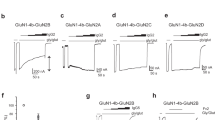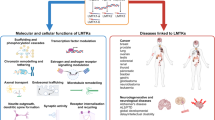Abstract
Are small-molecule, ligand-independent drugs for receptor-mediated diseases on the horizon?
This is a preview of subscription content, access via your institution
Access options
Subscribe to this journal
Receive 12 print issues and online access
$209.00 per year
only $17.42 per issue
Buy this article
- Purchase on Springer Link
- Instant access to full article PDF
Prices may be subject to local taxes which are calculated during checkout
Similar content being viewed by others
References
Barbacid, M. 1993. Nerve growth factor: a tale of two receptors. Oncogene 8: 2033–2042.
Jing, S., Tapley, P., and Barbacid, M. 1992. Nerve growth-factor mediates signal transduction through Trk homodimer. Neuron 9: 1067–1079.
Stahl, N., and Yancopoulos, G. 1993. The alphas, betas, and kinases of cytokine receptor complexes. Cell 74: 587–590.
Baumann, H., Ziegler, S., Mosley, B., Morella, K., Panjovic, S., and Gearing, D. 1993. Reconstitution of the response to leuke mia inhibitory factor, oncostatin M, and ciliary neurotrophic factor in hepatoma cells. J. Biol. Chem. 268: 8414–8417.
Pharr, P., Hankins, D., Hofbauer, A., Lodish, H. and Longmore, G. 1993. Expression of a constitutively active erythropoietin receptor in primary hematopoietic progenitors abrogates eryth ropoietin dependence. Proc. Natl. Acad. Sci. U.S.A. 90: 938–942.
Delachapelle, A., Traskelin, A., and Juvonen, E. 1993. Truncated erythropoietin receptor causes dominantly inherited benign human erythrocytosis. Proc. Natl. Acad. Sci. U.S.A. 90: 4495–4499.
Knusel, B., and Hefti, F. 1992. K-252 Compounds: Modulators of neurotrophin signal transduction. J. Neurochem. 59: 1987–1996.
Maroney, A., Forbes, M.E., Glicksman, M., Lipfert, L., Neff, N., Siman, R., Farah, J., and Dionne, C. 1993. K252A induces tyrosine phosphorylation and differentiation in SY5 Y cells inde pendently of protein kinase-C inhibition. Annual Meeting of the Society for Neuroscience Abstract, Nov. 7–12, Washington, DC.
Glicksman, M., Prantner, J.E., Meyer, S., Forbes, M.E., Dasgupta, M., Lewis, M., and Neff, N. 1993. K-252a and staurosporine promote choline acetyltransferase activity in rat spinal cord cultures. J. Neurochem. 61: 210–221.
Rabin, S., Cleghon, V., and Kaplan, D. 1993. SNT, a differentiation-specific target of neurotrophic factor-induced tyrosine kinase activity in neurons and PC 12 cells. Mol. Cell. Biol. 13: 2203–2213.
Author information
Authors and Affiliations
Rights and permissions
About this article
Cite this article
Edgington, S. Neuronal Signal Transduction: Will Controlling Phosphorylation Cure Disease?. Nat Biotechnol 11, 1237–1241 (1993). https://doi.org/10.1038/nbt1193-1237
Issue Date:
DOI: https://doi.org/10.1038/nbt1193-1237



